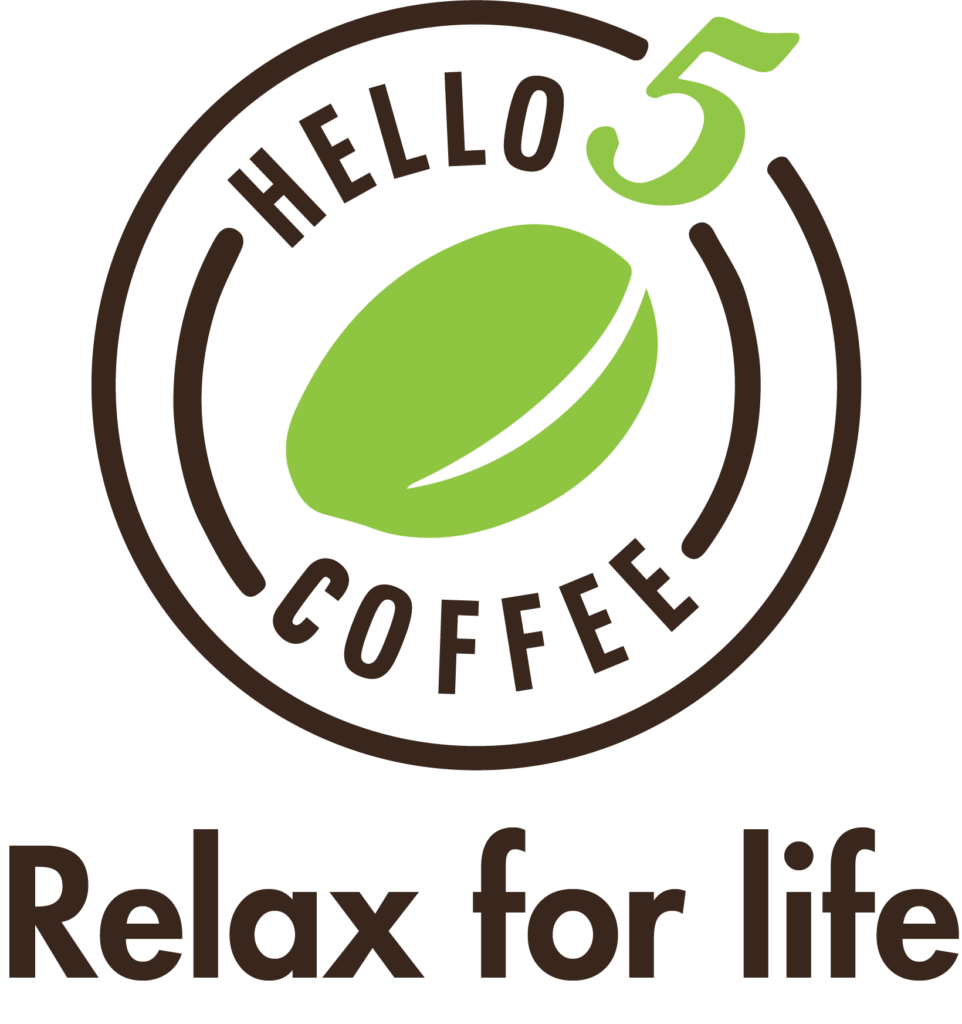Is opening a coffee shop profitable? Whether you’re starting with a small-scale shop or modest initial capital, you can absolutely create a stable income stream by applying the right strategies. Hello 5 Coffee Global has previously ventured into coffee shop entrepreneurship and has gained considerable experience in the industry. Therefore, through this article, Hello 5 Coffee Global wishes to share in detail 7 essential experiences for opening a coffee shop that aspiring entrepreneurs need to know!
Experience #1: Market Research and Finding Coffee Shop Business Ideas
Opening a coffee shop is no longer a distant dream for those who love business and coffee shop entrepreneurship. However, to avoid the risk of misguided investment, the first and most important experience in opening a coffee shop is conducting thorough market research and finding a suitable coffee shop business idea. So what do you need to open a coffee shop? To answer that question and conduct market research, you will need to follow these steps.
Step 1: Survey the Area and Consumer Behavior
You will need to consider factors such as:
- Location: Consider population density, foot traffic, average living standards.
- Consumer behavior: Do local residents have the habit of drinking coffee in the morning, afternoon, or evening? Do they usually come to cafés to chat, work, or take social media photos?
- Target customer groups: Are they students, office workers, elderly people, or tourists?
Tip: You can conduct quick surveys by observing, asking opinions from local residents, or researching online from various internet sources to gather feedback.
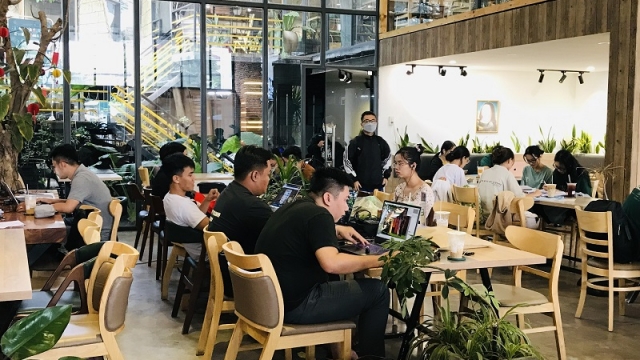
Step 2: Analyze Competitors
In this step, you need to identify how many coffee shops are in the area. What business model does each shop serve? (traditional coffee, takeaway coffee, garden coffee, specialty coffee, etc.). Along with pricing, beverage quality, shop style, and customer service. Just spend one session experiencing coffee at each shop and you can know what competitors are doing, their strengths and weaknesses.
Step 3: Research Current Market Trends
Understanding market trends helps you build a coffee shop that suits consumer preferences. Some prominent current trends:
- “Green & sustainable” coffee: focusing on environmentally friendly products.
- Specialty coffee: emphasizing coffee bean origins and special brewing methods. If you’re skilled at brewing, you can focus on coffee quality and open a specialty coffee shop.
- Minimalist, Japanese, Mediterranean style coffee shops, etc.: If you like design, create a shop with a unique concept and many Instagram-worthy corners.
- Combining coffee with coworking spaces, libraries, or workshops.
- Garden coffee shops for those who like scenery: If you love nature, build an airy garden coffee shop.
One coffee shop opening experience that Hello 5 Coffee Global wants to share with those planning to open a shop is: don’t try to please everyone. Clearly identify your target customer base and serve them best. But don’t be afraid to experiment either. Because the idea you think is “weird” might actually be the highlight that attracts customers. And you should start with a small model to test the market before expanding.
Experience #2: Location Selection and Premises Rental
Location selection and premises rental is one of the core coffee shop opening experiences that determines the success of a coffee shop. Even if you have creative ideas, delicious drinks, or impressive spaces, choosing the wrong location will significantly limit your potential customer base.
First, you need to identify who your target customers are. Only then can you determine where to locate your coffee shop. For example, if your target customers are students, the coffee shop should be near schools and dormitories. If target customers are office workers, the coffee shop must be near office buildings. If target customers like to work, the coffee shop should be in a quiet area with ample parking.
Some criteria for evaluating a prime location for a coffee shop include:
- Foot traffic density: Prioritize busy streets, near markets, schools, offices, or residential areas.
- Visibility: The shop should be easily visible, have prominent signage, not blocked by trees or utility poles.
- Parking space: Don’t underestimate this criterion, especially if your customers travel by motorbike or car.
- Suitable area: Depending on the business model, the area should be at least 30-60m² or more. You need areas for brewing, serving, and restrooms.
- Spacious, easy-to-decorate space: Prioritize places with wide frontage, square space, minimal renovation needed.
Next, you need to pay attention to the coffee shop premises rental period. The ideal rental period should be at least 1-3 years to ensure stability. If you invest heavily in renovation and design, negotiate a longer period with the landlord. Reasonable rental costs should not exceed 20-30% of expected monthly revenue. For example: If you expect revenue of 60 million VND/month, rental costs should range from 12-18 million VND/month.
You also need to ensure your shop premises has clear legal status. Note whether the landlord legally owns the premises, whether the premises has F&B business permits, and whether there are any ongoing disputes. Also pay attention to infrastructure. Are electricity, water, and internet stable? Are there existing drainage systems and sewers, or do they need renovation? Are walls, ceilings, and floors deteriorated or water-damaged?
Some coffee shop opening experiences for you when negotiating premises rental:
- Negotiate the best rental price: Especially if you commit to long-term rental or renovate the premises yourself.
- Request free/renovation time: Propose 15-30 days free initially for renovation and shop setup.
- Clearly state rights and obligations in the contract: Including: deposit, price increase conditions, incidental costs (garbage, water, electricity, taxes…).
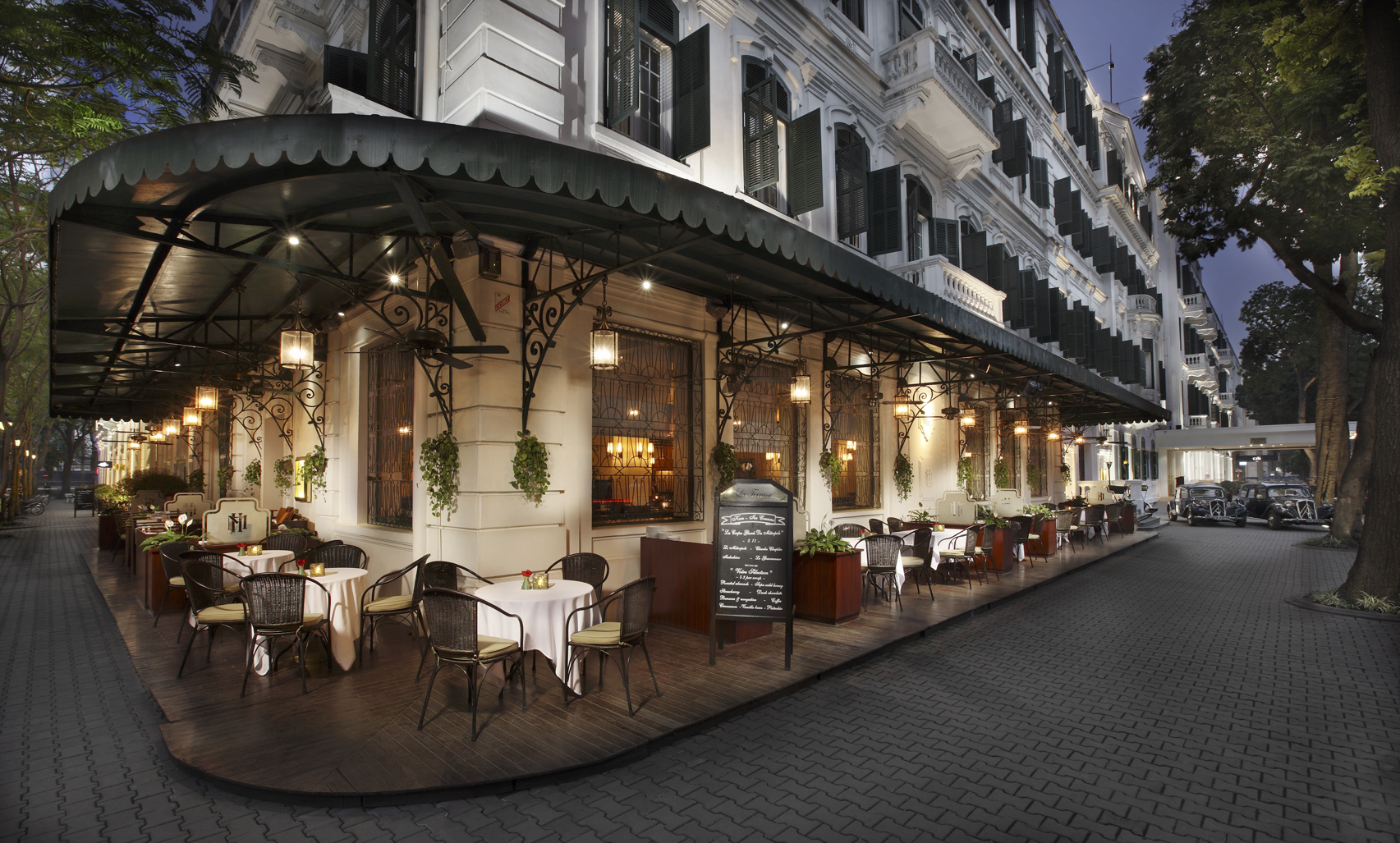
Don’t just visit the premises at one fixed time. Return in the morning (peak hours), afternoon (office workers’ break time), and evening (when people gather and relax). This helps you assess actual foot traffic, natural lighting, and noise levels in the area. Additionally, common mistakes when renting premises for opening a coffee shop that you should avoid:
- Renting too hastily for fear of losing opportunities → Easy to choose the wrong location or be pressured on price.
- Not considering the area at different time frames → Missing “dead” times with no customers.
- Not negotiating hidden costs clearly → Such as maintenance fees, cleaning costs, insurance…
- Not having a clear contract → Easy to face risks of early premises repossession.
Experience #3: Shop Space Design
Coffee shop space is not just a place to enjoy beverages, but also a venue for meeting friends, working, relaxing, or taking social media photos. Therefore, designing an impressive coffee shop space suitable for your target customer base is an important coffee shop opening experience no less important than beverage quality or premises location.
After knowing your target customer profile from the research step, you will choose a shop style suitable for your customers. For example, if you open a coffee shop for young people who like social media, suitable styles would be modern, minimalist, pastel colors. The shop space needs Instagram-worthy decorative corners, good lighting, and easy check-in backgrounds. Furniture should include soft sofas, wooden tables, and decorative plants. If your coffee shop serves office workers, styles you can try include vintage, retro, classical. You should prioritize comfortable seating for long periods, power outlets, strong wifi, long tables, chairs with backrests, and quiet spaces.
Important elements in coffee shop space design include:
- Reasonable space layout: You need to design the front of house (FOH) area (such as the brewing bar, ordering area, customer seating, takeaway waiting area) and back of house (BOH) functional areas (such as kitchen, raw material storage, toilets, dishwashing area). Ensure reasonable flow between staff and customers, avoiding collisions or crowding.
- Lighting and colors: Maximize natural light if you have windows or skylights. Use warm yellow lights for relaxing spaces, white lights for work areas. Colors should be harmonious, reflecting the main style. Don’t use too many hot colors that cause eye strain.
- Sound and fragrance: Avoid echoes and loud noise by using wooden furniture and fabric for sound absorption. You can play soft background music depending on the time of day. Shop fragrance should be pleasant – light coffee aroma and natural essential oils create a relaxing feeling.
Besides that, don’t make mistakes when designing your coffee shop, such as:
- Overemphasizing form while ignoring function → Customers have difficulty moving, staff serve inefficiently.
- Confusing design lacking focal points → Makes customers feel tired and hard to remember.
- Not considering maintenance and cleaning costs → Expensive repair costs during operation.
- Forgetting customer experience → Such as no place for handbags, uncomfortable seating.
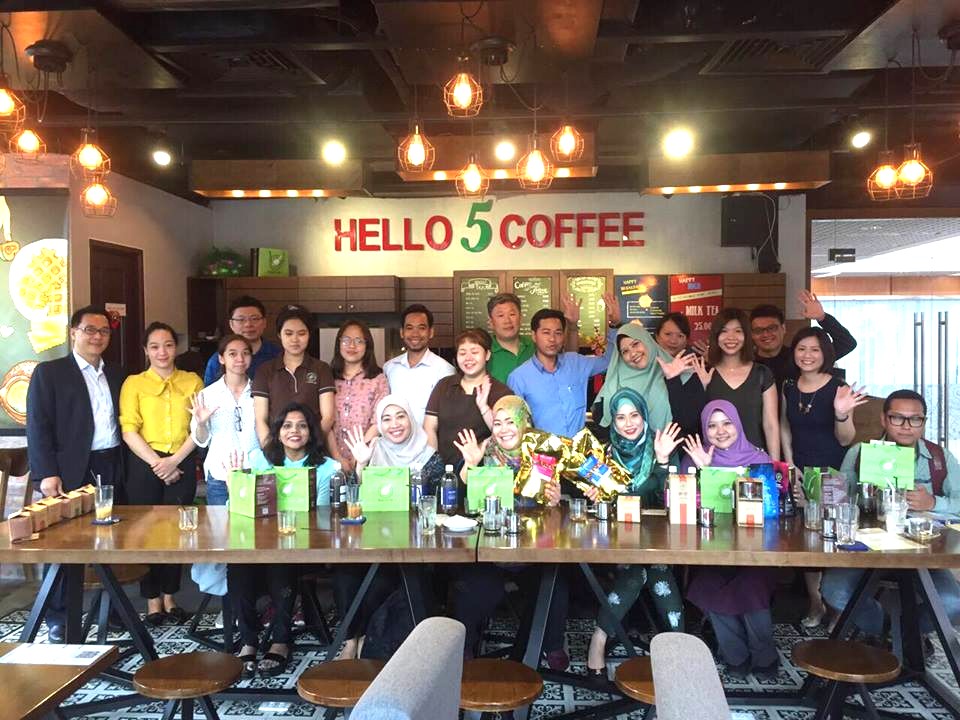
Experience #4: Building a Beverage Menu
A menu is not just a list of beverages, but also the “brand face” and an effective business tool for a coffee shop. A smartly built menu will help increase customer experience, create a unique impression, and optimize revenue.
A coffee shop beverage menu should typically include these product groups:
- Traditional coffee: Black iced coffee, brown iced coffee, white coffee.
- Machine-brewed coffee: Espresso, Americano, Cappuccino, Latte.
- Non-coffee drinks: Milk tea, fruit tea, juice, smoothies.
- Signature drinks (shop specialties): Original creations bearing the shop’s name – the highlight that makes you different.
- Seasonal drinks: Cold drinks in summer, hot drinks in winter, or trendy items.
Small tip: Don’t put too many items on the initial menu, start with 15-25 items and gradually expand based on customer feedback.
In your menu, you also need to name products reasonably. Product names should be short, memorable, and if possible, connected to emotions or the brand. For example: “Cloud White Latte,” “Peach Tea Morning Sun,” “Civet Coffee Signature.” Under product names, include brief descriptions (under 15 words) to help customers quickly understand ingredients and flavors. For example: “Rich black coffee brewed with traditional Vietnamese filter.”
Your menu should have low-price bait products, main products (best sellers), and high-profit products. Don’t forget to calculate indirect costs: ice, cups, straws, labor, equipment depreciation, etc. A pricing example: Ingredient cost 10,000 VND → selling price should be around 25,000-30,000 VND (gross profit margin ~60-70%).
Menu design should be easy to read and guide customer behavior. Some menu design tips you need to know:
- Arrange by clear groups, prioritize bestsellers at the top.
- Use beautiful illustrative images, but don’t make it too cluttered.
- Use prominent symbols (🌟 or “Best Seller”) for main items.
- Limit page count: ideally 1-2 A4 pages or neat hanging board**.
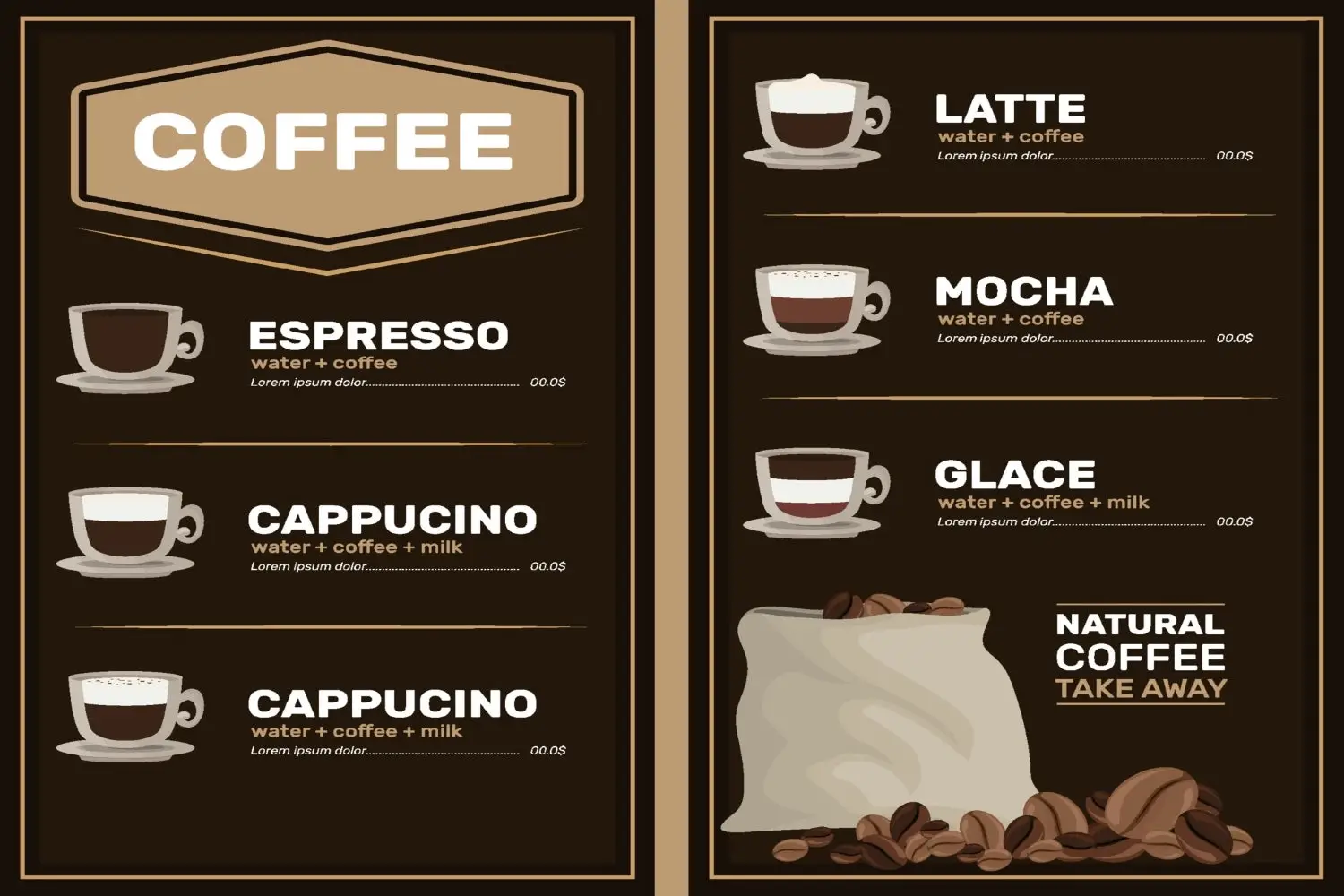
Additionally, you need to know some coffee shop opening experiences to increase order value through your menu:
- Suggest combos of drinks + pastries or snacks to increase average order value.
- Smart upselling: For example: “Add topping +5k,” “Upgrade to large size +10k.”
- Update menu seasonally or according to trends: Summer add juices, cold brew, fruit teas. Winter add hot chocolate, hazelnut latte. Following trends, add cream cheese milk tea, matcha foam, etc.
Experience #5: Purchasing Brewing Equipment and Ingredients
Choosing the right equipment and quality ingredients not only ensures delicious drinks but also helps save costs, ensures stable operation, and builds long-term reputation with customers. From Hello 5 Coffee Global’s coffee shop opening experience, below is a list of some necessary equipment and brewing tools.
Common Coffee Brewing Equipment
Depending on your shop model (traditional, modern, takeaway…), you can choose suitable equipment:
- Espresso machine: For shops specializing in machine-brewed coffee (Latte, Cappuccino…)
- Coffee grinder: Should use adjustable grind size type
- French Press, stainless steel filter: For traditional filter coffee service.
- High-power blender: For making smoothies and crushed ice drinks.
- Cream/milk foam maker, water kettle, juice extractor, tea maker…
Money-saving tip: If you’re just opening a small shop, you can buy used machines from reputable sources or rent espresso machines to reduce initial investment costs.
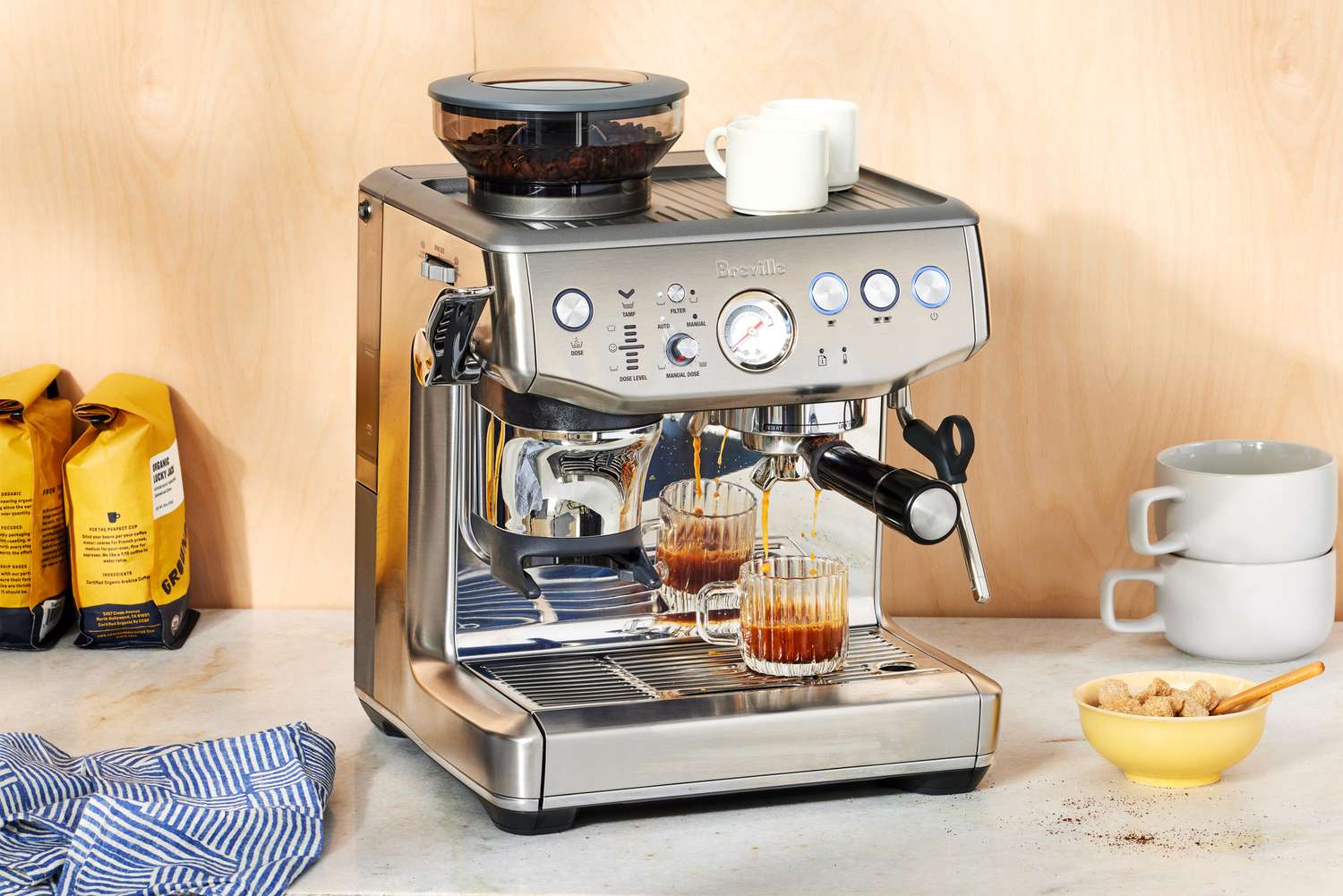
Brewing Tools to Prepare
For brewing, you need to invest in tools such as:
- Shakers, stirring spoons, measuring cups, ice scrapers.
- Tea steepers, milk frothers, strainers, funnels, syrup dispensers.
- Ice trays, refrigerators, dry ingredient containers (matcha, cocoa…).
Invest in quality, easy-to-clean, and durable tools, as they will be used frequently every day.
Brewing Ingredients
Ingredients are indispensable. Good ingredients create good products that keep customers coming back. From our coffee shop opening experience, below are the ingredient groups you need to prepare:
- Coffee beans: Choose reputable coffee suppliers with clear information about origin, growing region, and roasting. For machine coffee, choose high-quality Arabica or Arabica + Robusta blend, medium-dark roast. For filter coffee, choose dark-roasted Robusta for the rich, sweet aftertaste and traditional bitterness. Test many samples before deciding to buy large quantities.
- Syrups and brewing sauces: Choose famous brands (Torani, Monin, Hershey’s…) to ensure consistent flavor and safety.
- Various teas: Black tea, green tea, oolong tea, fruit tea. Prioritize types that retain aroma well with few impurities.
- Milk and plant-based cream: Choose types for brewing, easy to store and good for foaming.
- Matcha powder, cocoa, toppings (jelly, pearls, cream cheese…): Check expiration dates and store properly.
- Fresh fruits: Should have stable suppliers to ensure quality and pricing.
So where can you buy these ingredients? You can purchase directly from distributors. They offer good prices for large quantities, authentic products, and warranty policies. Or you can order online on major platforms, but the disadvantage is you may not see the goods before purchasing.
For example, if you want to source coffee bean ingredients, you can contact Hello 5 Coffee Global directly for pricing on each product line. Hello 5 Coffee Global supplies roasted & ground coffee, coffee beans & instant coffee in large quantities to coffee distributors domestically and for export. They have several support programs for retail partners such as discounts from 20% revenue and above, regular marketing/promotional activities to support sales, etc.
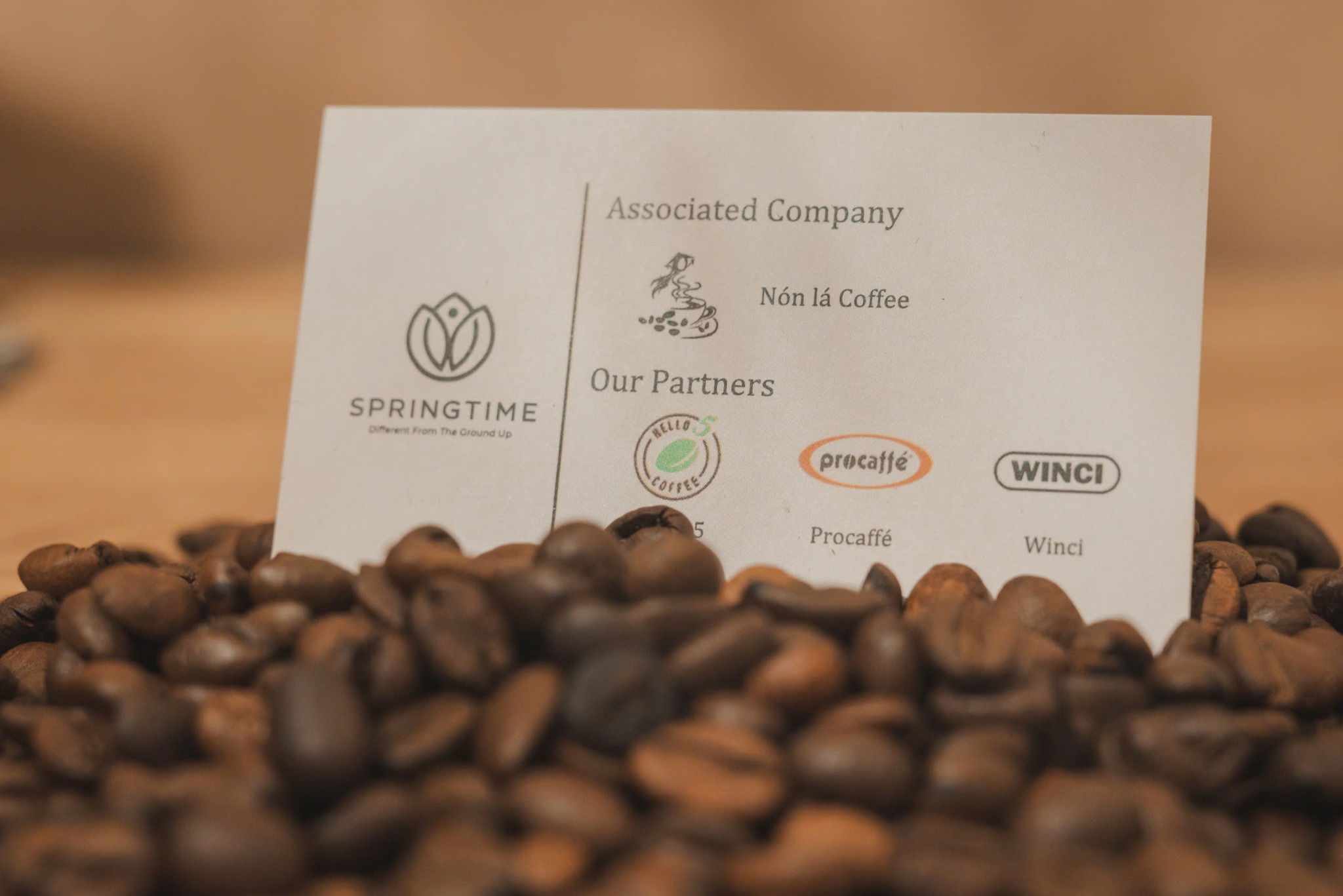
Read more: Top 5 Vietnamese Roasted Coffee Brands
Experience #6: Financial Planning and Necessary Costs
How much money do you need to open a coffee shop? To start smoothly and avoid “financial breakdown,” an important coffee shop opening experience is having a clear, realistic financial plan. Many people fall into capital shortage right when their shop hasn’t had time to stabilize due to negligence or inaccurate cost estimation. Below is an example of cost analysis for opening a coffee shop that you need to consider:
| COST CATEGORY | DETAILS | ESTIMATED COST (VND) |
|---|---|---|
| 1. Premises & Infrastructure | ||
| Deposit + 1 month rent | Deposit 1 month, rent 1 month (example: 20 million/month) | 40,000,000 |
| Renovation & premises repair | Ceiling, flooring, painting, electrical, plumbing | 20,000,000 |
| Signage, menu, wall decoration | Complete renewal | 20,000,000 |
| Total Category 1 | 80,000,000 | |
| 2. Furniture & Equipment | ||
| Tables, chairs, bar counter, shelves | Wood, metal, simple decor | 30,000,000 |
| Espresso machine (1-2 group) | Can buy new or authentic used machine | 25,000,000 |
| Coffee grinder | Basic or semi-professional type | 5,000,000 |
| Blender/juice extractor | For non-coffee drinks | 4,000,000 |
| Brewing tools (shaker, spoons, pitchers…) | Cups, measuring pitchers, milk steamers, filters… | 6,000,000 |
| Refrigerator, small freezer | Ingredient storage | 7,000,000 |
| POS + receipt printer | Simple sales software | 3,000,000 |
| Total Category 2 | 80,000,000 | |
| 3. Initial Brewing Ingredients | ||
| Coffee beans (filter + machine) | For first 2-3 weeks | 4,000,000 |
| Syrups, sauces, toppings, brewing powders | For milk tea, fruit tea, crushed ice items | 6,000,000 |
| Tea, milk, cream, dry ice | Basic ingredients | 4,000,000 |
| Packaging: plastic cups, paper bags, straws | If selling takeaway | 2,000,000 |
| Total Category 3 | 16,000,000 | |
| 4. Initial Staff & Training | ||
| Staff salary (2-3 people/month) | Cashier + barista + server | 30,000,000 |
| Basic brewing skills training | Can self-train or invite experts | 5,000,000 |
| Uniforms, miscellaneous staff costs | Aprons, hats, name tags… | 2,000,000 |
| Total Category 4 | 37,000,000 | |
| 5. Marketing and Grand Opening | ||
| Brand identity design | Logo, menu design, posters | 2,000,000 |
| Online advertising | Facebook Ads, grand opening posts | 3,000,000 |
| Grand opening promotions | Discounts, free products, combos | 3,000,000 |
| Total Category 5 | 8,000,000 | |
| 6. Reserve Fund | ||
| Operation 1-2 months without profit | Including ingredients + salary + risk costs | 50,000,000 |
| Total Category 6 | 50,000,000 | |
| TOTAL INITIAL ESTIMATED COST | (Total all categories 1 to 6) | 271,000,000 |
The above is just initial estimated costs. Monthly, you also have to pay for costs such as:
Monthly Operating Costs
- Premises rental fee
- Electricity – water – internet
- Staff salaries
- Ingredients
- Equipment depreciation
- Maintenance, cleaning, small item replacement costs
Depending on your shop model, you will have different budget estimates:
| Shop Model | Minimum Budget |
|---|---|
| Mini takeaway shop | 70 – 100 million |
| Small coffee shop (30-50m²) | 150 – 200 million |
| Medium shop (>60m²) | 250 – 400 million |
| Specialty/large investment shop | 500 million and above |
Some important notes when creating a cost table:
- Don’t put 100% of capital into opening the shop, always reserve at least 10-15% as emergency fund
- Prioritize spending on quality equipment and ingredients, as these directly affect the product
- Check and compare prices from multiple suppliers before purchasing
- Reinvest from revenue, don’t borrow too much to open a shop if you lack experience
Experience #7: Operations Management
After opening your coffee shop, the most important thing to maintain stable operations and long-term development is effective operations management. Whether you invest large or small, without good management skills, the shop easily falls into chaos, customer dissatisfaction, staff departure, and prolonged losses. Below are daily tasks you need to manage based on our coffee shop opening experience.
Staff Management
You need to hire the right people for the right roles. Choose staff with service spirit, agility, and honesty. You need at least 1 head barista, 1 assistant barista/cashier, 1-2 servers. For small shops, hire versatile staff who can work multiple positions.
Next, you need to train your staff in brewing skills, hygiene, service, and customer situation handling. Build standard operating procedures (SOPs) for each specific task. Additionally, for shift scheduling and attendance management, you can use staff management apps to track attendance and leave. Shift scheduling should be fair, avoiding overlaps that cause internal conflicts.

Service Process and Product Quality Management
To maintain consistent quality, you need to standardize drink recipes and ingredient quantities (use measuring cups, electronic scales). Regularly taste drinks from different staff members to ensure flavor consistency.
To optimize service processes, service time should not exceed 7-10 minutes from when customers order. Build reasonable service flow diagrams: order → payment → brewing → service → cleanup.
Ingredient and Inventory Management
To control input-output-inventory, you can use management software to track inventory. Create goods receipt forms, check ingredients weekly to prevent loss. Ordering should follow proper cycles. Fresh ingredients should be ordered daily or every 2-3 days. Dry ingredients and toppings should be ordered weekly or monthly. You can minimize ingredient waste by creating brewing quantity standards for each item, strictly supervising shift starts and ends, and regularly checking inventory.
Financial and Cash Flow Management
You will have to track daily revenue-expenses through methods such as accurately recording each sales receipt via POS software. Separate different cost types clearly: ingredients, salaries, marketing, utilities, etc. to create basic weekly/monthly financial reports. Don’t spend more than 70-80% of monthly revenue. Also establish emergency funds to handle situations of low customer traffic or unexpected cost increases.

Customer Management and Marketing
You will manage your customers from these perspectives:
- Build customer loyalty programs: Point accumulation – reward exchange via apps (Loyalty, Loyverse). Give vouchers, birthday discounts, seasonal combos.
- Manage online sales channels: Register to sell on GrabFood, ShopeeFood, BeFood if possible. Maintain fanpage, Instagram, TikTok to attract new customers.
- Retain loyal customers: Ensure consistent experience in drinks, service, and space. Proactively ask for feedback and improve based on suggestions.
Effective coffee shop operations management is a synthesis of many skills: people management, materials, finance, service, and customers. For beginners, you may face many challenges in coffee shop opening experience. But if you build a proper operating system from the start, have clear processes and continuously improve, your shop will not only operate smoothly but also develop stably and sustainably long-term.
Opening a coffee shop is not easy, but it’s not too difficult if you have thorough preparation and learn from the coffee shop opening experience of predecessors. Start with passion, but operate with reason and specific plans. Hello 5 Coffee Global wishes you success with your own coffee shop!
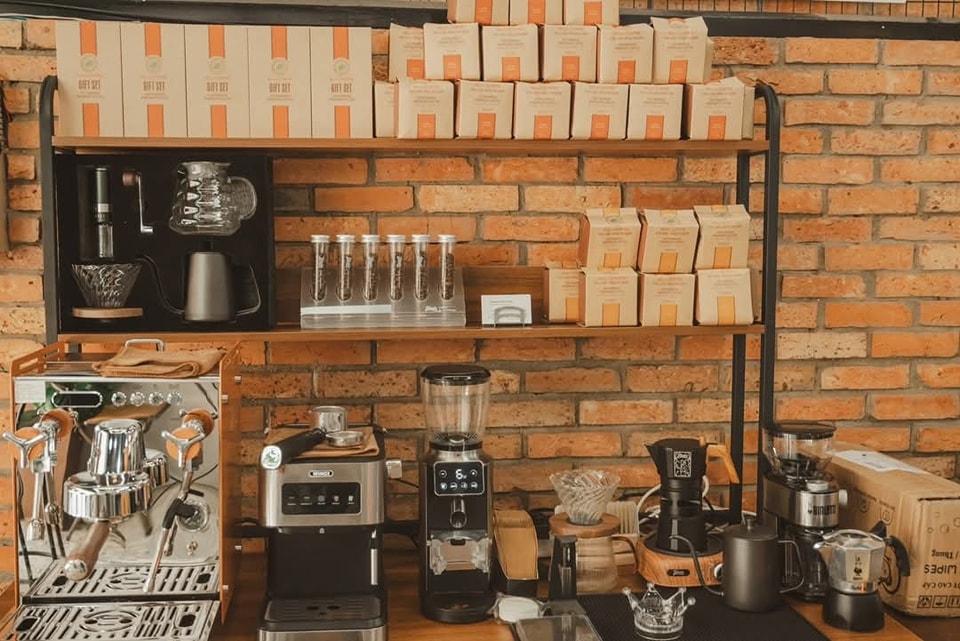
We are always here to provide ingredients and successful coffee shop opening secrets to support you in your shop business. You can contact us through the following channels:
- Headquarters: No. 73, To Hien Thanh Street, Phuc La Ward, Ha Dong District, Hanoi City.
- Email: info@hello5coffee.com
- Phone: (+84) 81 535 5505
- Website: hello5coffee.com
Hello 5 Coffee Global is a leading roasted coffee supplier in Vietnam, specializing in providing high-quality roasted coffee to coffee shops, distributors, and wholesale partners worldwide. We offer comprehensive B2B solutions including bulk supply, private labeling, OEM/ODM services, and export capabilities to support coffee businesses globally.
